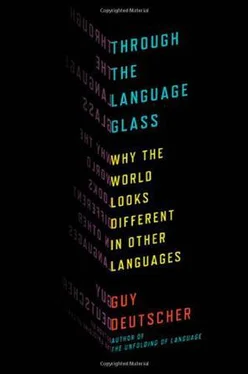I can sense that you are not ready to give up so easily. If the notion of difficulty will not do, you may now suggest, then what about basing the definition of complexity on a more objective measure, such as the number of parts in the language system? Just as a puzzle is more complex the more pieces it has, couldn’t we simply say that the complexity of language is determined by the number of distinct forms it has, or the number of distinctions it makes, or the number of rules in its grammar, or something along these lines? The problem here is that we will be comparing apples and oranges. Language has parts of very different kinds: sounds, words, grammatical elements such as endings, types of clauses, rules for word order. How do you compare such entities? Suppose language X has one more vowel than language Y, but Y has one more tense than X. Does this make X and Y equal in overall complexity? Or, if not, what is the exchange rate? How many vowels are worth one tense? Two? Seven? Thirteen for the price of twelve? It is even worse than apples and oranges, it is more like comparing apples and orangutans.
To make a long story short, there is no way to devise an objective and non-arbitrary measure for comparing the overall complexity of any two given languages. It’s not simply that no one has bothered to do it-it’s inherently impossible even if one tried. So where does all this leave the dogma of equal complexity? When Joe, Piers, and Tom claim that “primitive people speak primitive languages,” they are making a simple and eminently meaningful statement, which just happens to be factually incorrect. But the article of faith that linguists swear by is even worse than wrong-it is meaningless. The alleged central finding of the discipline is nothing more than a hollow mouthful of air, since in the absence of a definition for the overall complexity of a language, the statement that “all languages are equally complex” makes about as much sense as the assertion that “all languages are equally cornflakes.”
The campaign to convince the general public of the equality of all languages may be paved with best intentions, for it is undoubtedly a noble enterprise to disabuse people of the belief that primitive tribes speak primitive languages. But surely the road to enlightenment is not through countering factual errors with empty slogans.

While the pursuit of the overall complexity of language is a wild-goose chase, there is no need to give up on the notion of complexity altogether. In fact, we can considerably improve our chances of catching something meaty if we turn away from the phantom of overall complexity and instead aim for the complexity of particular areas of language. Suppose we decide to define complexity as the number of parts in a system. If we delineate specific areas of language carefully enough, it becomes eminently possible to measure the complexity of each of these areas individually. For example, we can measure the size of the sound system simply by counting the number of phonemes (distinct sounds) in a language’s inventory. Or we can look at the verbal system and measure how many tense distinctions are marked on the verb. When languages are compared in this way, it soon emerges that they vary greatly in the complexity of specific areas in their grammar. And whereas the existence of such variations is hardly stop-press news in itself, the more challenging question is whether the differences in the complexity of particular areas might reflect the culture of the speakers and the structure of their society.
There is one area of language whose complexity is generally acknowledged to depend on culture-this is the size of the vocabulary. The obvious dividing line here is between languages of illiterate societies and those with a written tradition. The aboriginal languages of Australia, for example, may have many more words than the two hundred that the Cairns radio presenter was granting them, but they still cannot begin to compete with the word hoard of European languages. Linguists who have described languages of small illiterate societies estimate that the average size of their lexicons is between three thousand and five thousand words. In contrast, small-size bilingual dictionaries of major European languages typically contain at least fifty thousand entries. Larger ones would contain seventy to eighty thousand. Decent-size monolingual dictionaries of English contain about a hundred thousand entries. And the full printed edition of the Oxford English Dictionary has around three times that many entries. Of course, the OED contains many obsolete words, and an average English speaker would recognize only a fraction of the entries. Some researchers have estimated the passive vocabulary of an average English-speaking university student at about forty thousand words-this is the number of words whose meaning is recognized, even if they are not actively used. Another source estimates the passive vocabulary of a university lecturer at seventy-three thousand words.
The reason for the great difference between languages with and without a written tradition is fairly obvious. In illiterate societies, the size of the vocabulary is severely restricted precisely because there is no such thing as “passive vocabulary”-or at least the passive vocabulary of one generation does not live to see the next: a word that is not actively used by one generation will not be heard by the next generation and will then be lost forever.
MORPHOLOGY

While the cultural dependence of the vocabulary is neither surprising nor controversial, we are entering more troubled waters when we try to ascertain whether the structure of society might affect the complexity of areas in the grammar of a language, for instance its morphology. Languages vary considerably in the amount of information they convey within words (rather than with a combination of independent words). In English, for example, verbs like “walked” or “wrote” express the pastness of the action within the verb itself, but they do not reveal the “person,” which is instead indicated with an independent word like “you” or “we.” In Arabic, both tense and person are contained within the verb itself, so that a form like katabn means “we wrote.” But in Chinese, neither the pastness of the action nor the person is conveyed on the verb itself.
There are also differences in the amount of information encapsulated within nouns. Hawaiian does not indicate the distinction between singular and plural on the noun itself and uses independent words for the purpose. Similarly, in spoken French, most nouns sound the same in the singular and plural ( jour and jours are pronounced in the same way, and one needs independent words, such as the definite article le or les , to make the difference heard). In English, on the other hand, the distinction between singular and plural is audible on the noun itself (dog-dogs, man-men). Some languages make even finer distinctions of number and have special forms also for the dual. Sorbian, a Slavic language spoken in a little enclave in eastern Germany, distinguishes between hród, “a castle,” hródaj , “two castles,” and hródy , “[three or more] castles.”
The information specified on pronouns also varies between languages. Japanese, for instance, makes finer distinctions of distance on demonstrative pronouns than modern English. It differentiates not just between “this” (for close objects) and “that” (for objects farther away) but has a three-way division between koko (for an object near the speaker), soko (near the hearer), asoko (far from both). Hebrew, on the other hand, makes no such distance distinctions at all and can use just one demonstrative pronoun regardless of distance.
Читать дальше













